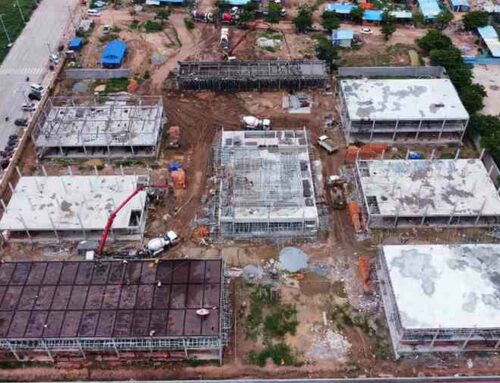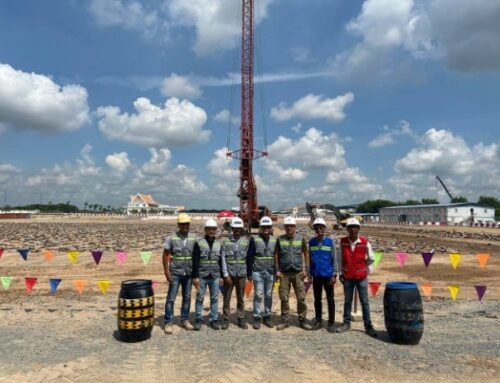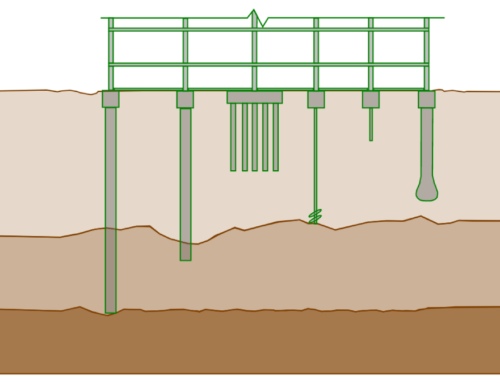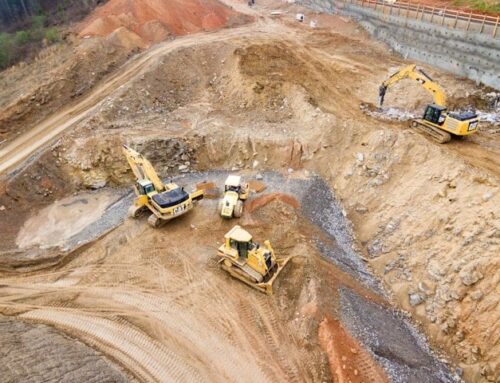Imagine a city where buildings tilt, roads warp, and infrastructure collapses, all because the ground beneath suddenly loses its strength. This dramatic scenario is the result of soil liquefaction, a phenomenon where saturated soil temporarily behaves like a liquid, often triggered by seismic activity.
Understanding what soil liquefaction is and how it can impact construction and engineering projects is vital for professionals in these fields.
In this article, we will explore the causes, effects, and mitigation techniques of soil liquefaction, providing you with the knowledge to recognize and address this significant geotechnical challenge.
What is Soil Liquefaction?
Soil liquefaction occurs when saturated soil substantially loses strength and stiffness in response to an applied stress, such as an earthquake or other sudden changes in stress conditions. This process transforms the soil from a solid state into a liquid state.
At its core, soil liquefaction is a phenomenon where water-saturated granular soil temporarily loses its strength and acts more like a viscous liquid than a solid. This change can cause significant ground deformation and is a major concern in seismic zones.
The term “soil liquefaction” was first coined in the early 1950s by Japanese geotechnical engineers Mogami and Kubo in their pioneering work, “The Behavior of Soils During Vibration.”
Their research described experiments on how sand and loam behave when subjected to vertical harmonic vibration, laying the foundation for understanding the phenomenon.
Soil liquefaction refers to the loss of shear strength of soil under monotonic or cyclic loading, often resulting from a tendency for loose soil to compact under shear loading.
The phenomenon gained significant attention in the geotechnical engineering profession in the 1960s after large earthquakes in Niigata, Japan, and Alaska, USA. These events highlighted the severe impacts of soil liquefaction, as widespread ground failure led to the collapse of buildings, bridges, and other infrastructure.

Effects of soil liquefaction caused by the earthquake on apartment buildings in Niigata
The dramatic effects of these earthquakes spurred extensive research into understanding and mitigating soil liquefaction, making it a critical consideration in modern engineering and construction practices, especially in seismic regions.
Causes of Soil Liquefaction
Soil liquefaction is a complex phenomenon influenced by various factors that can significantly compromise the stability of structures. Understanding these causes is essential for developing effective mitigation strategies. The primary causes of soil liquefaction include seismic activity, soil saturation, soil composition and properties, and human activities and construction impacts.
1. Seismic Activity
Earthquakes are the most common triggers of soil liquefaction.
The intense shaking during an earthquake generates stress waves that propagate through the soil, causing saturated, loose granular soils to lose their structure and strength.
This shaking can rearrange the soil particles into a denser configuration, squeezing water out of the pore spaces and reducing the effective stress, ultimately leading to liquefaction.
Read also: Why Soil Behaviour is Important in Construction?
2. Saturation of Soil
For soil liquefaction to occur, the soil must be saturated or nearly saturated with water.
Saturated soils have their pore spaces filled with water, which can become pressurized during an earthquake or other stress event. This pressure buildup reduces the contact forces between soil particles, making it easier for the soil to behave like a liquid.
Areas with high groundwater tables or poor drainage are particularly susceptible to liquefaction.
3. Soil Composition and Properties
The type and properties of soil play a crucial role in its susceptibility to liquefaction. Loose, poorly compacted, granular soils such as sand are most prone to liquefaction. These soils have large pore spaces that can easily become pressurized.
The particle size distribution, shape, and gradation also affect how easily the soil can densify and lose strength under stress. Cohesive soils, like clay and silt, generally have a lower risk of liquefaction because their particles are more tightly bound together.
4. Human Activities and Construction Impacts
Human activities, such as construction and land development, can also contribute to the risk of soil liquefaction.
Excavation, pile driving, and other construction activities can disturb the soil structure, making it more susceptible to liquefaction during an earthquake. Additionally, the addition of fill material, changes in drainage patterns, and alterations to the natural groundwater level can impact soil stability.
By understanding these causes, engineers and construction professionals can better assess liquefaction risks and implement appropriate ground improvement and mitigation techniques to safeguard structures and infrastructure.
Effects of Soil Liquefaction
Soil liquefaction can have severe and far-reaching impacts on the built environment and the natural landscape. The primary effects include structural damage, ground deformation, and environmental and economic consequences. Understanding these effects is crucial for engineers and planners to design resilient infrastructure and mitigate the risks associated with liquefaction.
A. Structural Damage
One of the most immediate and visible effects of soil liquefaction is the damage to buildings and other structures. When the ground loses its strength and behaves like a liquid, it can no longer support the weight of structures built on it.
This loss of support can cause buildings to tilt, sink, or collapse. Foundations may crack or break, and utility lines, such as water, gas, and sewage, can rupture, leading to further damage and potential hazards.

Sinking cars in Christchurch caused by Soil liquefaction, New Zealand (Source)
Notable examples of structural damage due to liquefaction include the 1964 Niigata earthquake in Japan, where entire buildings tilted and sank into the ground, and the 1989 Loma Prieta earthquake in California, which caused significant liquefaction-related damage in the Marina District of San Francisco.
B. Ground Deformation
Liquefaction can lead to various forms of ground deformation, including lateral spreading, ground oscillation, and settlement.
Lateral spreading occurs when the liquefied soil flows horizontally, often towards a free face such as a riverbank or excavation, causing significant horizontal displacement of the ground.

Ground Deformation Illustration
This can shear off bridge abutments, pipelines, and other underground structures. Ground oscillation is the back-and-forth movement of the ground surface, which can further destabilize structures.
Settlement occurs when the soil compacts and sinks after the excess pore water pressure dissipates, leading to uneven ground surfaces and further compromising the integrity of buildings and infrastructure.
C. Environmental and Economic Impacts
The environmental impacts of soil liquefaction include changes to the landscape, such as the creation of sand boils, fissures, and cracks in the ground. These changes can disrupt ecosystems, affect water quality, and lead to erosion. Economically, the damage caused by liquefaction can be devastating.
The costs of repairing and rebuilding infrastructure, coupled with the economic losses from business interruptions and reduced property values, can be substantial.
For instance, the 1995 Kobe earthquake in Japan resulted in approximately $100 billion in economic losses, with a significant portion attributed to liquefaction-related damage.
D. Case Studies of Soil Liquefaction Events
1. 2004 Indian Ocean Tsunami (Indonesia)
The 2004 Indian Ocean tsunami, triggered by a massive undersea earthquake, caused extensive liquefaction in coastal areas of Indonesia.

This event led to the collapse of numerous buildings and infrastructure, displacing entire communities. The widespread liquefaction was a significant factor in the destruction seen in the affected areas. (Source)
2. 2018 Sulawesi Earthquake (Indonesia)
On September 28, 2018, a magnitude 7.5 earthquake struck Central Sulawesi, causing significant liquefaction in the city of Palu.

Liquefaction resulting from mudflows in Palu City: (a) Map of Palu City, (b) Balaroa mudflows, (c) Petobo mudflows, and (d) Jono Oge mudflows. (Source)
The liquefaction resulted in widespread damage, with many buildings collapsing and substantial loss of life. The event highlighted the severe impact of liquefaction in urban areas, exacerbating the destruction caused by the earthquake.
3. Moro Gulf Earthquake (1976, Philippines)
The Moro Gulf earthquake, which occurred on August 17, 1976, triggered liquefaction in various coastal areas of the Philippines. The event caused widespread destruction, highlighting the liquefaction risks in densely populated regions. The resulting damage emphasized the need for improved building practices and ground assessment in areas prone to seismic activity.
Identification and Assessment of Liquefaction Risk
Identifying and assessing the risk of soil liquefaction is a critical step in mitigating its potential impacts on infrastructure. Several methods have been developed to evaluate liquefaction potential, each offering unique insights and advantages. The following are the key methods used in the assessment of liquefaction risk:
1. Simplified Method
The Simplified Method is based on empirical correlations and is widely used due to its ease of application and rapid results. Developed by Seed and Idriss in the 1970s, this method compares the cyclic stress ratio (CSR) induced by an earthquake to the cyclic resistance ratio (CRR) of the soil. The method utilizes standard penetration test (SPT) data and empirical relationships to estimate the CRR, making it a practical tool for preliminary assessments.
2. Stress-Based Method
The Stress-Based Method involves evaluating the stress conditions in the soil and is often used in conjunction with other methods to provide a comprehensive assessment. This method considers the cyclic shear stresses induced by seismic loading and compares them to the soil’s shear strength. It requires detailed information about the soil profile and seismic loading conditions, making it more complex but also more precise than the Simplified Method.
3. Energy-Based Method
The Energy-Based Method focuses on the energy dissipation during cyclic loading and is used to estimate the liquefaction potential of soils. This method assesses the amount of energy required to cause soil deformation and compares it to the energy imparted by an earthquake. By considering the energy aspects of soil behavior, this method provides an alternative perspective to stress-based approaches and is particularly useful for understanding the mechanisms of soil failure.
4. Cone Penetration Test (CPT) Method
The Cone Penetration Test (CPT) Method involves using CPT data to determine the liquefaction potential of soils by analyzing factors such as cone resistance and sleeve friction. The CPT provides continuous and detailed profiles of soil resistance, allowing for accurate identification of susceptible layers. Empirical correlations and direct measurements from the CPT data are used to assess the likelihood of liquefaction, making this method highly reliable and widely adopted in geotechnical engineering.
5. Shear Wave Velocity Method
The Shear Wave Velocity Method uses shear wave velocity data to estimate the liquefaction potential of soils, often in combination with other methods. Shear wave velocity is a measure of the soil’s stiffness and resistance to shear deformation. By correlating shear wave velocity with empirical thresholds for liquefaction, this method provides a non-invasive means of evaluating soil stability. It is particularly useful for assessing deep soil layers and complex soil profiles.
6. Liquefaction Potential Index (LPI) Method
The Liquefaction Potential Index (LPI) Method calculates an index based on various soil parameters to estimate the likelihood of liquefaction. The LPI considers factors such as soil density, grain size distribution, and groundwater conditions, integrating them into a single index that reflects the overall susceptibility of the site. This method provides a comprehensive overview of liquefaction risk, making it valuable for large-scale assessments and urban planning.
7. Tools and Technologies Used in Risk Assessment
Advances in technology have enhanced the accuracy and efficiency of liquefaction risk assessment. Modern tools such as geotechnical software, remote sensing, and geophysical techniques complement traditional methods, offering more precise and comprehensive evaluations.
Technologies like ground-penetrating radar (GPR), electrical resistivity tomography (ERT), and seismic tomography are increasingly used to map subsurface conditions and identify potential liquefiable layers.
By employing a combination of these methods and leveraging advanced technologies, engineers can effectively assess and mitigate the risks associated with soil liquefaction, ensuring the safety and resilience of structures and infrastructure.
Read also: Soils that we treat using Stone Column
Mitigation and Prevention Techniques
Mitigating and preventing the impacts of soil liquefaction is essential for ensuring the stability and safety of structures in susceptible areas. Various ground improvement methods and engineering solutions have been developed to address liquefaction risks. Here, we explore some of the most effective techniques:
Ground Improvement Methods
1. Dynamic Compaction
Dynamic compaction involves dropping heavy weights from a significant height onto the ground to densify loose, granular soils. This process increases the soil’s density and strength, reducing its susceptibility to liquefaction. Dynamic compaction is particularly effective for large areas and can be tailored to meet specific site conditions.
2. Vibro Compaction
Vibro compaction uses vibrating probes to rearrange soil particles into a denser configuration. The probes are inserted into the ground and vibrated, causing the surrounding soil to compact. This method is suitable for sandy and gravelly soils and is often used in conjunction with other ground improvement techniques.
3. Controlled Modulus Columns (CMC)
Controlled Modulus Columns (CMC) are a patented ground improvement solution created by Menard Group. CMC rigid inclusions are grouted inclusions designed to reinforce soil, increasing bearing capacity and controlling settlement. Installed using a displacement auger, this technique generates minimal spoil and improves the global response of the soil rather than acting as distinct structural elements like piles. CMC rigid inclusions can be designed to provide both bearing capacity and settlement control for vertical loads.
4. Stone Columns
Stone columns are constructed by creating holes in the ground while filling them with compacted gravel or crushed stone by vibration and compaction effort. The columns improve drainage, increase shear strength, and reduce compressibility, thereby mitigating the risk of liquefaction. This method is effective for soft and loose soils and can be used in various soil conditions.
5. Jet Grouting
Jet grouting involves injecting high-pressure grout into the soil to form solidified columns or panels. The grout mixes with the soil, creating a composite material with improved strength and stiffness. Jet grouting is versatile and can be used in a wide range of soil types and conditions, making it an effective solution for liquefaction mitigation.
6. Soil Mixing
Soil mixing combines soil with cementitious or chemical binders to create a stabilized mass with enhanced properties. This method involves mechanically mixing the binders with the soil in situ, resulting in improved strength and reduced permeability. Soil mixing is particularly useful for treating soft clays and silts prone to liquefaction.
Engineering Solutions and Best Practices
1. Seismic Design and Retrofitting
Designing structures to withstand seismic forces is a crucial aspect of liquefaction mitigation. This includes using flexible foundations, base isolators, and other seismic-resistant features. Retrofitting existing structures with additional support or modifying foundation systems can also enhance their resistance to liquefaction-induced damage.
2. Drainage Improvements
Improving soil drainage can help reduce the risk of liquefaction by lowering the groundwater table and preventing the buildup of pore water pressure. Techniques such as installing vertical drains, horizontal drains, and drainage wells can effectively manage groundwater levels and enhance soil stability.
3. Groundwater Control
Controlling groundwater levels through dewatering or the installation of cutoff walls can prevent the saturation of soils and reduce the risk of liquefaction. These measures are particularly important in areas with high groundwater tables or where construction activities have altered natural drainage patterns.
4. Regular Monitoring and Maintenance
Implementing a regular monitoring and maintenance program is essential for identifying and addressing potential liquefaction risks. This includes conducting periodic geotechnical assessments, monitoring groundwater levels, and inspecting structures for signs of distress. Proactive maintenance can help detect issues early and ensure the continued stability of the ground and structures.
By employing these mitigation and prevention techniques, engineers and construction professionals can significantly reduce the risk of soil liquefaction, ensuring the safety and longevity of structures in earthquake-prone regions.
Menard Asia’s Role in Addressing Soil Liquefaction
Menard Asia has played a pivotal role in addressing soil liquefaction across various regions, implementing innovative ground improvement techniques and providing robust engineering solutions.
Our expertise and patented technologies, such as Controlled Modulus Columns (CMC), have been instrumental in mitigating the risks associated with soil liquefaction. Below are several case studies highlighting Menard Asia’s significant contributions to this field.
Case Study 1: Kiantar Airport, Indonesia
At Kiantar Airport in Poto Tano, West Sumbawa Regency, Indonesia, Menard Asia was tasked with reinforcing the soft soils beneath the runway extension to improve stability and support aircraft loads.
The project, commissioned by PT PP (Persero) Tbk for PT Amman Mineral Nusa Tenggara (AMNT), required substantial ground improvement to support its structural pavements, including the runway, taxiway, and apron.
Soil Condition
The project site presented a variety of soil conditions. The southern runway area was characterized by sandy soil extending up to 8 meters deep, underlain by very dense sand up to 20 meters. Conversely, the northern runway area consisted of clayey soil at the surface, extending to a depth of 8 meters, followed by medium stiff clay. The taxiway and apron areas featured loose to medium sand.
Menard Solution
To address these soil challenges, Menard implemented Dynamic Compaction (DC) to densify the sandy soil at the southern runway, transforming it from a loose to a dense state to control liquefaction risks. In the northern runway area, Controlled Modulus Columns (CMC) rigid inclusions were used to manage excessive settlement and provide long-term stability. These techniques ensured that the taxiway and apron areas were also treated to mitigate settlement and liquefaction risks. The combination of DC and CMC techniques provided a stable foundation, crucial for the longevity and safety of the airport infrastructure.
Case Study 2: RDMP Balikpapan, Indonesia
In the RDMP Balikpapan project, Menard Asia was tasked with improving the ground conditions for the expansion of a major refinery in Indonesia. The site conditions included loose, water-saturated soils that posed a significant risk of liquefaction. Menard Asia used a combination of ground improvement techniques, including the installation of CMCs and other methods, to stabilize the soil. This comprehensive approach mitigated the risk of liquefaction and ensured the stability of the refinery’s structures. The successful implementation of these techniques demonstrated Menard Asia’s ability to handle complex geotechnical challenges and provided a solid foundation for the refinery’s expansion.
Through these case studies, Menard Asia demonstrates its commitment to providing innovative and effective solutions to mitigate soil liquefaction risks. By leveraging advanced ground improvement techniques, such as CMC rigid inclusions, Menard Asia ensures the stability and safety of infrastructures, contributing to the resilience of built environments across the globe.
Read: Consolidation : Earthquake Drains
Conclusion
Soil liquefaction poses a significant risk to infrastructure, particularly in seismic regions like Indonesia, Thailand, and Philippines. Understanding the causes, effects, and assessment methods is crucial for mitigating its impact.
Through advanced ground improvement techniques and innovative solutions, Menard Asia has demonstrated its expertise in addressing these challenges effectively. The use of ground improvement methods such as the compaction method, Stone Columns or Controlled Modulus Columns (CMC) has proven to be a reliable and effective approach in enhancing soil stability and ensuring the safety and longevity of structures.
By implementing comprehensive risk assessment and employing tailored mitigation strategies, Menard Asia continues to play a vital role in improving ground conditions and preventing the adverse effects of soil liquefaction. Our commitment to innovation and excellence in geotechnical engineering sets a high standard in the industry, providing peace of mind to clients and contributing to the development of resilient infrastructures worldwide.
[addtoany]





